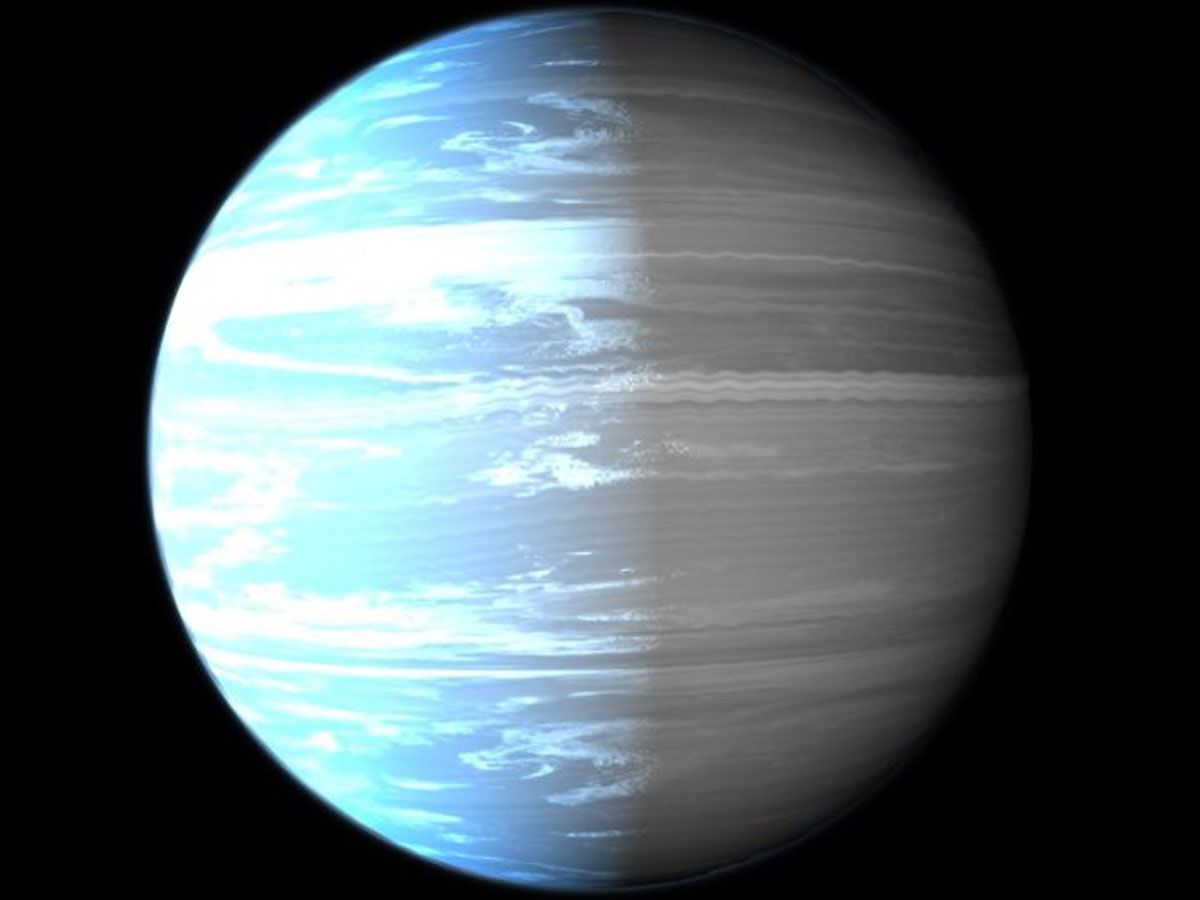WASP-76 b, an exoplanet positioned 634 light-years away in the Pisces constellation, has been an intriguing subject of study for its unconventional characteristics. With temperatures soaring up to 4,350 degrees Fahrenheit, it hosts an environment fierce enough to vaporize iron.
Surprisingly, recent analysis reveals that WASP-76 b's atmosphere contains remnants of a Mercury-sized planet, raising a multitude of intriguing questions about its history.
An Overview of WASP-76 b
While WASP-76 b shares its mass size resemblance to Jupiter, constituting 85% of the latter's mass, it exhibits an extraordinary distinction in other physical dimensions.
Due to the intense radiation from its nearby star, it has swelled to almost twice Jupiter's width and is six times its volume, earning it the descriptor "puffy."
A hallmark of WASP-76 b's uniqueness resides in the extreme thermal conditions that prevail on its surface.
With temperatures skyrocketing to a blazing 4,350 degrees Fahrenheit, this exoplanet's environment transcends the boundaries of what we typically expect from gas giants in our Solar System.

So extreme is the heat that it can vaporize iron, causing the once-solid element to exist in a gaseous state in the upper atmosphere.
Further enhancing its singularity, WASP-76 b showcases a tidal-locked orientation towards its star, similar to our moon's relation to Earth.
This orientation results in one side of the exoplanet perpetually basking in the fierce heat of its star, while the opposite side remains shrouded in relative coolness, a trait unseen in our solar system's gas giants.
Analyzing WASP-76 b's Atmosphere
To unlock the mysteries of WASP-76 b's atmosphere, a team of astronomers from Université de Montréal's Trottier Institute for Research on Exoplanets, led by Stefan Pelletier, employed the advanced MAROON-X spectrograph.

Mounted on the Gemini-North Telescope, this revolutionary instrument has allowed scientists to detect and measure the abundance of 11 chemical elements present in the exoplanet's atmosphere, including some that have never been found in gas giants such as Jupiter or Saturn.
The Role of Heat in Atmospheric Composition
The sweltering temperatures that permeate WASP-76 b's atmosphere serve as a potent transformative force, driving the evaporation of solid elements like magnesium and iron, and maintaining them as gases in the upper layers of the atmosphere.
This phenomenon paints a stark contrast with colder planets where these elements might condense and solidify.

However, the extreme heat appears to discriminate among the elements it vaporizes. Titanium and aluminum are absent in the gaseous soup, despite their presence in the star that WASP-76 b orbits.
This suggests that the heat threshold required to vaporize these particular elements exceeds even the astonishing temperatures found on WASP-76 b. Thus, it appears that temperature sensitivity plays a pivotal role in determining a gas giant's atmospheric composition.
Discovering Vanadium Oxide
Among the detected elements in the exoplanet's atmosphere, vanadium oxide, a compound bearing similarities to ozone found on Earth, was identified for the first time outside our Solar System.
In a surprising revelation, this molecule significantly influences the heating pattern of WASP-76 b's upper atmosphere.
Unlike on colder planets, where temperatures decrease as the altitude increases, the presence of vanadium oxide reverses this pattern on WASP-76 b, causing temperatures to rise with increasing altitude.
WASP-76 b's 'Planet Eating' Past
A detailed examination of WASP-76 b's atmosphere has given rise to a compelling theory about the exoplanet's past. Astronomers propose that this gas giant may have engulfed a Mercury-sized planet during its formative years.
This lesser celestial body, being composed chiefly of nickel-rich material, would have disintegrated and dispersed within WASP-76 b's intense atmospheric cauldron.
The preponderance of nickel in WASP-76 b's atmosphere lends significant credence to this theory. Ordinarily, one wouldn't anticipate such a copious concentration of nickel in the atmosphere of a gas giant.

However, WASP-76 b's nickel abundance surpasses what we might consider typical, suggesting that this extra material may indeed be the remnants of a smaller, nickel-rich terrestrial world that WASP-76 b consumed long ago.
This proposition opens up an entirely new perspective on how we view exoplanetary evolution and the fascinating, violent events that can shape their composition.
The Implications of the Study
The findings from the detailed study of WASP-76 b extend beyond the unusual characteristics of a single exoplanet. They underscore the fact that temperature sensitivity can greatly influence the makeup of a gas giant's atmosphere.
Certain elements might exist as gases, and others might be absent altogether, and the reason for this diversity could be linked to the varying heat thresholds required for different elements to vaporize.
Consequently, even slight temperature fluctuations could introduce considerable compositional differences between the atmospheres of gas giants.
Looking ahead, this new understanding paves the way for more targeted research in atmospheric sciences.

By recognizing that temperature plays a pivotal role in determining the atmospheric composition of gas giants, future studies can be tailored to explore how these temperature-induced variations affect the atmospheres of giant planets, both within and beyond our Solar System.
Additionally, the identification of a possible correlation between the element nickel and the consumption of a smaller terrestrial world points towards the rich histories that gas giants may harbor.
This insight also has significant implications for the study of planet formation and evolution, suggesting that many gas giants could bear atmospheric signatures of past planetary interactions.
Indeed, the meticulous study of WASP-76 b has been enlightening, demonstrating how investigations into distant worlds can enhance our understanding of the fundamental processes that shape planetary atmospheres.
Sources: nature.com












